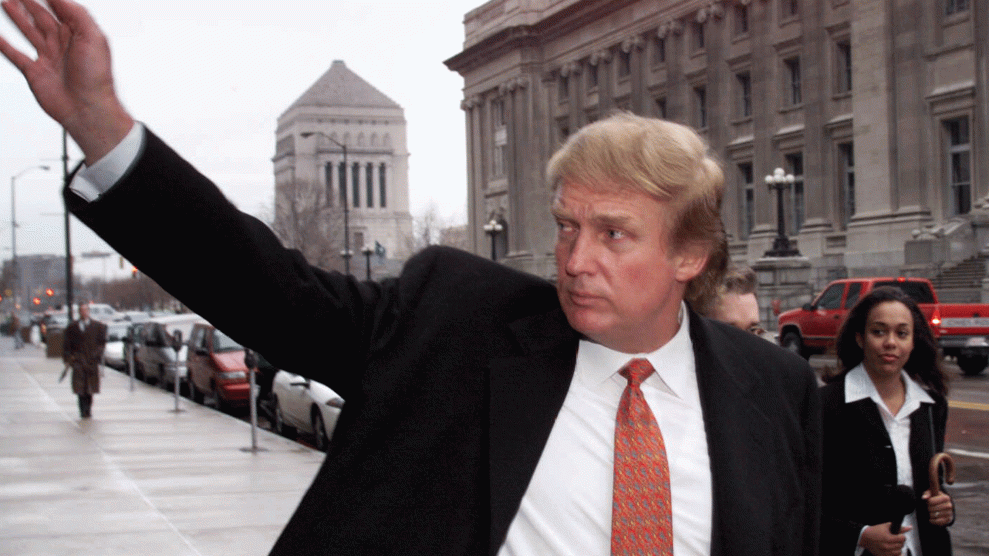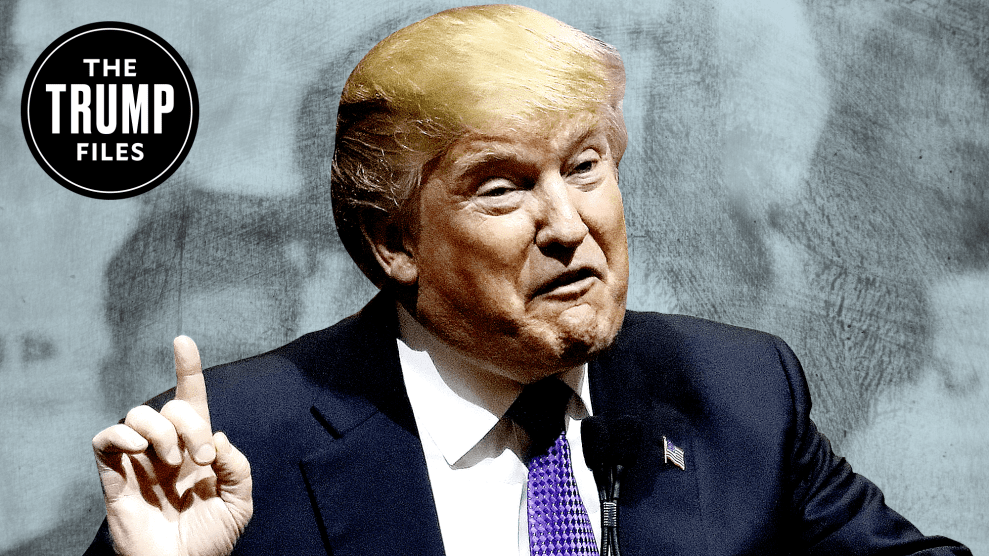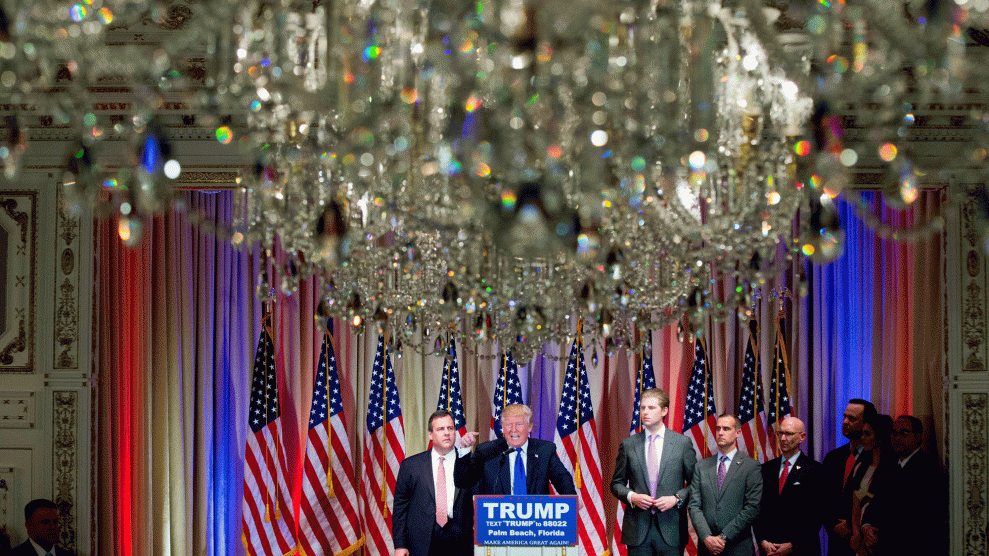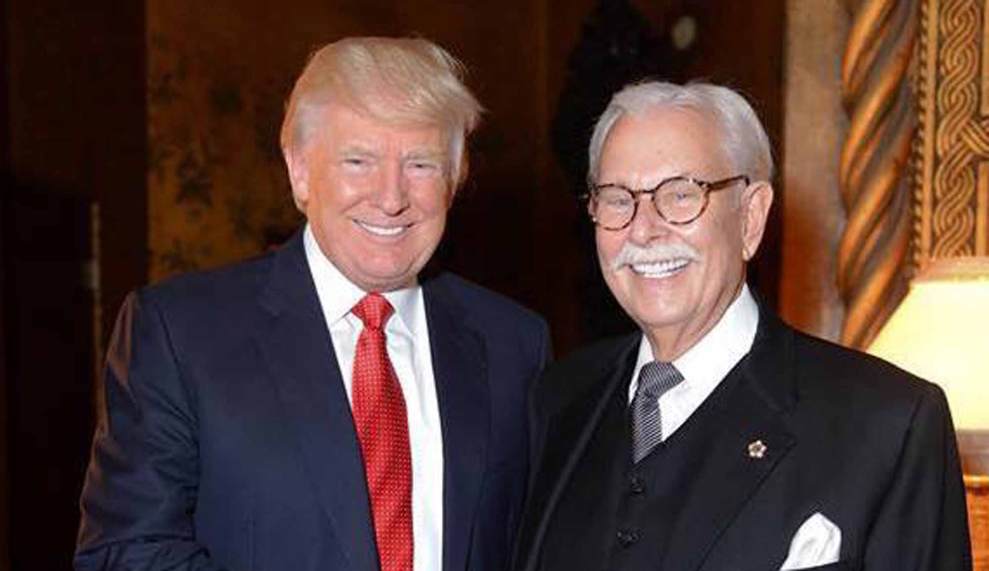
Donald Trump leaving the Indianapolis federal courthouse after testifying in a lawsuit against himAP Photo/Star-News, Rich Miller
In 1993, Donald Trump wanted to open a riverboat casino about 40 miles from Chicago in the troubled and violent city of Gary, Indiana. But he had a problem: Gary wasn’t keen on him. City officials were skeptical of Trump’s vow to invest in the city. After all, Trump’s Atlantic City casino empire, $1.5 billion in debt, was on the brink of bankruptcy. They recommended that the state grant Gary’s two riverboat gambling licenses to other companies.
What Trump did to overcome their objections and win a lucrative Indiana casino license is a case study in his business practices. It’s a tale of intense lobbying, political maneuvering, and, most notably, a broken promise to provide millions of dollars to local charities.
At the time Trump sought the casino license in Gary, the city’s population was about 80 percent black, and nearly 17 percent of its population lived in deep poverty. The city was dubbed the murder capital of America. In an effort to revive its flagging fortunes after the collapse of the steel industry, Gary officials had sought to capitalize on its proximity to Chicago to turn it into a gambling hub.
Trump had long opposed opening casinos in Indiana. Such a move would threaten his Atlantic City operation. In 1990, he told the Chicago Tribune that he would never open a casino in Gary and that setting up gambling establishments there would be a “very bad idea, not only for Gary but also for the Chicago area.” He contended that a Gary casino would “empty the pockets of people in Chicago” and increase welfare costs in Gary. “Gambling has not been the savior of Atlantic City,” Trump said. “We still have slums here.”
But a few years later, Trump changed his tune. In 1993, Indiana legislators voted to allow 11 riverboat casinos to open on Lake Michigan and elsewhere. Gary requested two of those casino licenses, and Trump wanted one of them. The competition for Gary’s licenses was fierce. Trump reportedly spent $1 million on a campaign to win the backing of local officials.
Charles Hughes was on the Gary city council at the time and in the room for many of the negotiations with Trump. “He promised everything,” Hughes recalls. “He was going to build these magnificent edifices in Gary. He was going to build giant hotels, he was going to hire all these people. He was going to change our world, until it came time to put it in writing.”
Gary officials recommended the state award the licenses to other suitors, including a company owned by Don Barden, a Detroit native and later the first African American to own a casino in Las Vegas. After Trump failed to win Gary’s endorsement, his lawyers recommended that Trump “Hoosierize” his application to the state to make it more attractive, according to legal documents. The attorneys suggested that Trump provide a 15 percent ownership interest in the riverboat casino to local investors.
Trump’s organization recruited eight local investors, six of whom were from Gary or the surrounding Lake County; all but one were minorities. One of the two investors from outside Gary was William Mays, perhaps Indiana’s most famous and successful black businessman. He owned a chemical company and one of the country’s oldest black newspapers, the Indianapolis Recorder. (He died in 2014.) Trump’s reps also enlisted Buddy Yosha, a prominent Indiana trial lawyer with strong ties to the state’s Democratic political establishment.
Aside from Mays and Yosha, most of the potential investors didn’t have the money to invest in Trump’s enterprise. (The shares they were offered would cost each investor about $1.4 million.) So his lawyers offered the group a sweetheart deal in which the company would finance the purchase of their shares in the riverboat—loans they would pay back with their dividends and distributions.
During the negotiations, Yosha suggested Trump sweeten his offer to the state. He proposed that instead of giving the full 15 percent interest to this small group of investors, Trump offer them 7.5 percent and use the other 7.5 percent to set up a foundation that would make donations to Indiana charities. The local investors would serve as trustees of the foundation and administer it to ensure its work benefited charities in Gary and the state. Trump’s firm agreed to the proposal.
Trump’s lawyers drew up a document creating the foundation and got the investors to approve its terms. They asked Yosha to draft a list of charities the foundation could support. A letter from Trump’s lawyer showed that the company had agreed on 35 charities, everything from Gamblers Anonymous to the Gary Commission on the Status of Women, food banks, homeless services, and groups that worked with the developmentally disabled. Then they sent the proposal to the Indiana gaming commission as part of Trump’s casino application. Trump’s representatives, according to legal filings, estimated during a hearing on the application that the arrangement would translate to about $11.5 million for the foundation. The gambit seemed to work. In December 1994, the state agreed to give Trump’s company one of the two Gary gaming licenses.
Then Trump’s company promptly dumped all the local minority investors, along with the promise to place 7.5 percent of the riverboat ownership into a foundation.
The news came as a shock to the would-be investors. Only months earlier, Trump’s lawyers had sent letters to them that appeared to seal the deal. A February 1994 letter to Mays from Trump’s lawyers said, “We are very pleased that you are now an investor in the Trump application for a riverboat gaming license in Indiana.” But after Trump’s company won the casino license, Yosha says his lawyers told the investors that nothing promised in the letters or the gaming license application was legally binding. “Everything had been oral,” says lawyer James Fisher, who represented the investors. But he maintains that the assorted letters, such as the one Mays received, were confirmation that a deal had been reached between Trump’s company and the investors.
Trump’s promise to the Indiana investors had become inconvenient. By 1995, his New Jersey operation was on the verge of forced bankruptcy after falling behind on the huge debt payments owed on his Atlantic City establishments. He needed the Indiana riverboat to save his company. Using the Gary casino as additional security, Trump was able to refinance his near-bankrupt New Jersey casinos through a public stock offering for a new firm that lumped together the Indiana property and some of the New Jersey properties. This arrangement made it difficult for Trump’s company to provide the minority investors or the foundation shares only in the Indiana riverboat.
In spring 1996, Trump unveiled the 290-foot casino boat, Trump Princess Indiana, and the jilted investors sued him and his company for breach of contract. Trump now routinely says he never settles lawsuits, but according to filings with the Securities and Exchange Commission, a year later, the company that Trump formed for the riverboat venture, Trump Indiana, settled with four of the plaintiffs in the case for a total of more than $1.4 million. Two others eventually received more than $800,000 combined.
The deals, though, didn’t end Trump’s legal troubles in Indiana. Mays and Yosha refused to settle. They were unhappy that Trump had reneged on his promise to create the local foundation. The proposed charitable foundation, according to legal filings, was the only reason that Mays had agreed to lend his name to Trump’s gambling license application. The case went to trial, and Trump himself testified for the defense.
In 1999, a federal jury awarded the pair $1.33 million. The jury found that Trump was not personally liable or guilty of fraud but that his company had broken a contract to give the two men shares of the Indiana casino. The jury also concluded that Trump’s firm had violated its contractual agreement to create the foundation with 7.5 percent of the riverboat ownership. By ridding itself of this obligation, Trump’s firm had avoided making a charitable contribution worth between $4.5 million and nearly $30 million, according to estimates by experts on both sides who testified at the trial.
The trial court judge signed off on the jury award to Yosha and Mays. But the fate of the multimillion-dollar foundation was not settled. The jury had found that Trump’s firm had breached its contract with Yosha and Mays to create a charitable foundation, but the judge had the final say over the details of the foundation. And he decided that Trump’s company didn’t have to put 7.5 percent of the riverboat ownership into a foundation because it had created a different foundation that the judge considered an acceptable substitute.
This other foundation was the result of behind-the-scenes political maneuvering by Trump’s operation. Unbeknown to Mays or Yosha, Trump, before dumping them and the other investors, had cut a deal with the new mayor of Gary, Scott King, who had been elected in November 1995, the first white person to hold the job in nearly three decades. As part of Trump Indiana’s casino license, his firm was required to have a development agreement with the city of Gary. During negotiations with the city, Trump’s lawyers persuaded the mayor to support the creation of a different foundation. This nonprofit would not be controlled by local investors. Rather, Trump himself would be president, and the other directors would be New Jersey-based employees of his firm. The mayor would be a trustee.
This foundation would not be funded by transferring valuable shares in the riverboat. Instead, Trump Indiana would give it an initial $1 million, followed by $100,000 annual donations. This money would fund a handful of $5,000 scholarships to Gary high school graduates every year. James Fisher, who represented the local investors, says Trump turned the foundation “into a political patronage thing, where the mayor would be able to pass it out.” (King denies his work with the foundation was a form of patronage, saying the public schools had a far greater role than he did in deciding where the money would go.)
The money in the alternative foundation “was a small fraction of what he had originally represented to the gaming commission,” says Fisher. In 1999, Trump Indiana had gross gaming revenues of $139 million. The $100,000 annual contributions to the Trump Indiana foundation amounted to 0.07 percent of the company’s gross gaming income—a far cry from the 7.5 percent ownership Trump’s firm had originally promised.
Yosha was upset over the judge’s ruling on the foundation, and he and Mays considered appealing the decision to press the courts to hold Trump’s company to its original agreement. Hoping to avoid further litigation, Trump’s lawyers proposed settling. In March 2000, according to one letter between Fisher and Yosha and Mays, Trump Indiana offered to pay Yosha and Mays a total of $1 million and donate a total of $500,000 to charity over the course of five years if they would not appeal.
The settlement offer put Yosha and Mays in a bind. Appealing the trial court ruling on the foundation would mean risking the money the jury had awarded them individually. Yet the jilted investors chose to appeal the judge’s ruling to “try to make Trump do what they committed themselves to doing, which is funding the charities,” Yosha says.
This gamble proved a bad one. The conservative 7th Circuit Court of Appeals overturned the jury verdict and sided with Trump, whose lawyers had argued that none of the promises they had made in letters to the investors constituted a binding contract. “We lost everything,” says Yosha, who is still steamed about the whole episode.
Yosha’s concerns about the Trump-controlled foundation—that it wouldn’t do much to help the needy of Indiana—were eventually confirmed. In 2005, with his gambling empire in shambles, Trump sold the Indiana riverboat for a quarter of a billion dollars to Barden, the African American casino magnate who owned the other Gary riverboat.
If Trump’s firm had stuck to its original promise to donate a 7.5 percent interest in the riverboat to a charitable foundation, the sale could have netted the foundation millions. Instead, the alternative Gary foundation received nothing from the sale. Barden eventually took over Trump’s Indiana foundation. He died in 2011, and what’s left of the nonprofit is now the Bella and Don Barden Foundation, run by Alana Barden, Barden’s 20-something daughter who lives in California.
According to its most recent available tax filings, from 2012 through 2014, the foundation has made donations to the Motown music museum, a golf club caddy scholarship fund, and a cancer center that treated Barden before he died. Each of these recipients is in Detroit. It also made a donation to the Skull and Dagger Foundation at the University of Southern California, Alana’s alma mater. During these same years, it handed out no money in Gary.

















